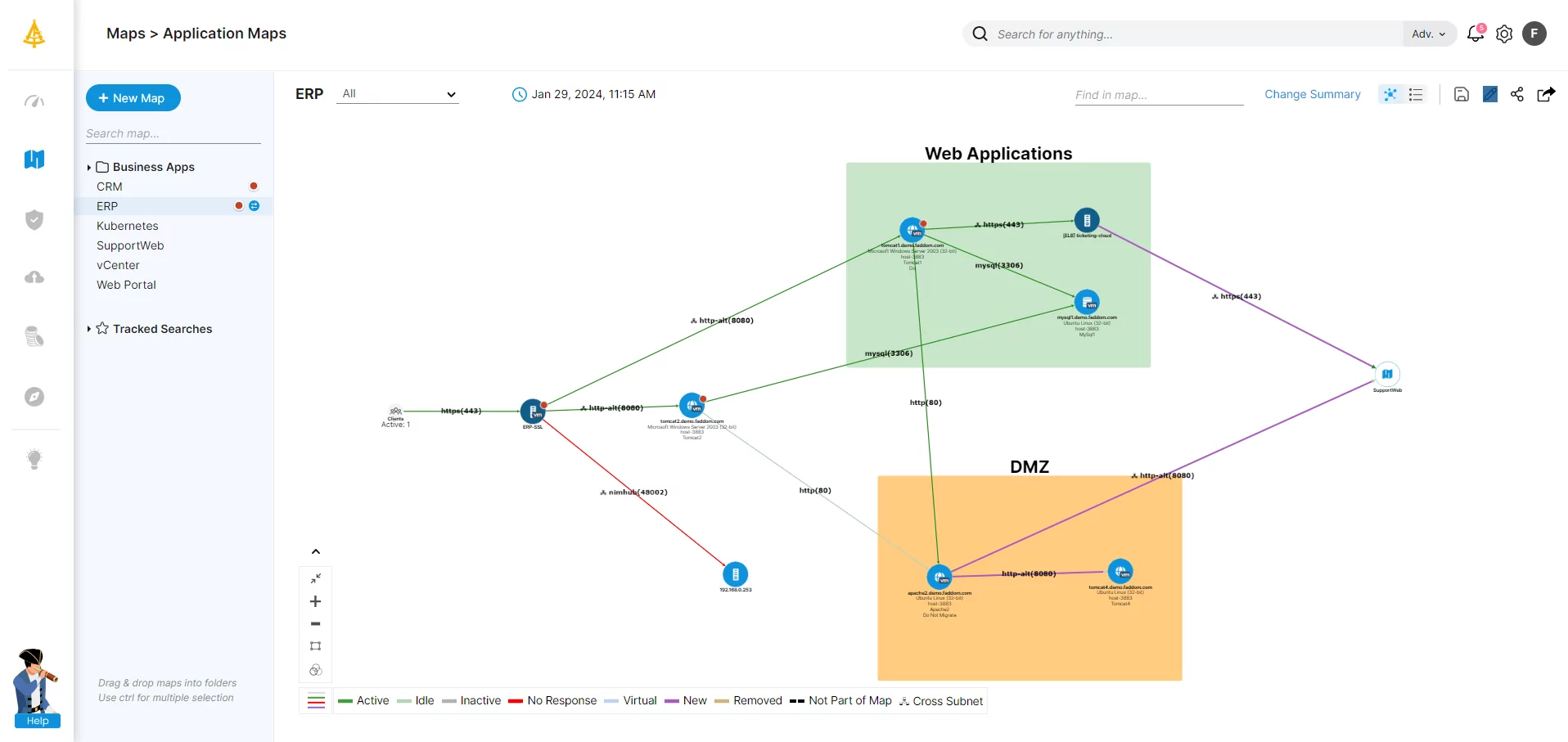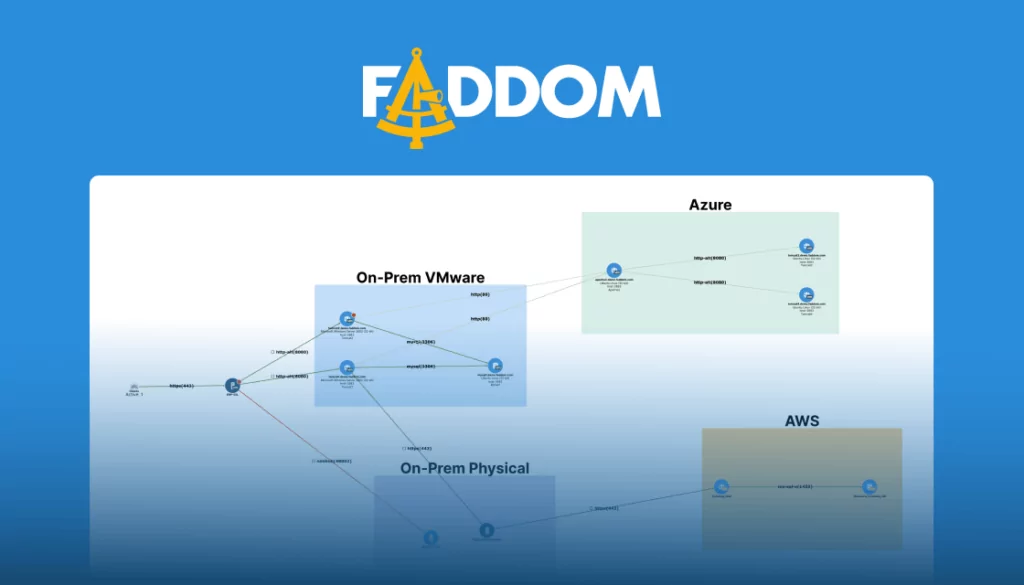What Are Application Portfolio Management Tools?
Application Portfolio Management (APM) tools are software solutions designed to assist organizations in managing their suite of IT software applications and services. These tools provide a comprehensive framework for IT leaders and decision-makers to catalog, monitor, and analyze their software assets, ensuring alignment with business goals and strategies.
APM tools provide insights about each application’s business value, cost, and technical condition, enabling informed decision-making regarding IT investments, optimizations, and retirements. By leveraging APM tools, organizations can achieve a holistic view of their application landscape, identifying redundancies, uncovering cost-saving opportunities, and prioritizing investments based on strategic importance and performance.
Table of Contents
ToggleKey Features of Application Portfolio Management Tools
An APM solution should provide the following capabilities:
Inventory Management
An APM tool should provide a centralized repository for detailed information about each application in the organization’s portfolio. This includes data on software versions, deployment environments, licensing, usage patterns, and ownership. Effective inventory management enables organizations to maintain an accurate and up-to-date overview of their application landscape.
Having a comprehensive inventory aids in identifying application overlaps and gaps within the portfolio, facilitating consolidation efforts and ensuring that each application serves a distinct, necessary function. By streamlining the application inventory, companies can reduce complexity, manage costs more effectively, and enhance the overall agility of their IT environment.
Application Discovery and Dependency Mapping
Application discovery and dependency mapping features allow organizations to automatically identify and catalog applications across their IT environment, including on-premises, cloud, and hybrid systems. This can help understand how applications interact with each other and with underlying infrastructure, creating a detailed map of dependencies.
This feature supports risk management by highlighting critical applications and their interdependencies, enabling more informed decision-making during IT transformations. It also simplifies the complexity of managing modern IT environments, where applications are increasingly distributed and interconnected, by providing clear visibility into the application ecosystem.
Cost Tracking and Financial Analysis
Cost tracking and financial analysis functionalities enable organizations to monitor and analyze the financial aspects of their application portfolios. This includes tracking direct costs like licensing and maintenance fees, as well as indirect costs such as support and infrastructure expenses. By understanding the total cost of ownership (TCO) of each application, companies can identify opportunities for cost reduction, such as retiring redundant or underutilized applications.
Financial analysis features also help in aligning IT spending with business value, ensuring that investments are directed towards applications that offer the highest return or strategic advantage. This capability supports more strategic budgeting and financial planning processes, optimizing the allocation of IT resources in support of business objectives.
Performance and Usage Monitoring
APM tools track metrics such as application availability, response times, and user activity levels, offering valuable data for assessing application health and effectiveness. Understanding application performance and usage patterns helps IT leaders make evidence-based decisions about where to invest in upgrades, which applications to retire, and how to improve user experience.
This continuous monitoring capability also enables proactive management of the application portfolio, allowing organizations to address performance issues before they impact business operations. By ensuring applications meet performance standards and user needs, companies can enhance productivity and maintain high levels of service quality.
Portfolio Rationalization
Portfolio rationalization is the systematic evaluation and management of the application portfolio to ensure it remains aligned with business strategies and objectives. This involves assessing the value, cost, risk, and performance of each application to determine its continued relevance and contribution to the organization.
Rationalization efforts can lead to decisions such as consolidating similar applications, upgrading strategic applications, or retiring obsolete ones. This can reduce complexity, lower costs, and focus resources on high-value applications that support business growth and innovation.
Learn more in our detailed guide to application rationalization.
Notable Application Portfolio Management (APM) Software
1. Faddom
Faddom is a solution that focuses on the inventory management and dependency mapping aspects of APM. It automatically discovers IT assets across hybrid environments, offering deep insights into application dependencies and network performance. It can visually map out IT infrastructures, making it easier for businesses to understand how applications interact within their systems.
Compared to other APM tools, Faddom can be deployed very quickly and is able to scan a large-scale environment in minutes. Its ability to detect and visualize the entire application ecosystem in real-time allows organizations to quickly respond to changes and potential issues. This makes Faddom invaluable for maintaining operational continuity and optimizing application performance across complex IT landscapes.
Learn more about Faddom or get a free trial using the sidebar form!

2. LeanIX
LeanIX offers a cloud-based APM solution that emphasizes continuous transformation and agile management of IT landscapes. It supports enterprises in creating transparent, well-documented portfolios that facilitate decision-making and compliance with IT standards. LeanIX provides actionable insights into technology risks, investment priorities, and optimization opportunities.
The platform’s interface and analytics tools enable users to track the lifecycle of applications and assess their impact on business processes. This helps in identifying redundant or outdated applications and enabling efficient resource allocation.
Source: LeanIX
3. ServiceNow
ServiceNow delivers an APM module within its broader IT service management (ITSM) solution, focusing on the integration of application data with IT operations. It provides a centralized platform for managing the health, performance, and cost of applications, enhancing visibility and control over the entire application portfolio.
Through its analytics and reporting capabilities, ServiceNow aids organizations in understanding application performance trends and making data-driven decisions to improve service delivery and operational efficiency.
Source: ServiceNow
4. Ardoq
Ardoq focuses on dynamic and data-driven documentation, providing a platform for enterprise architecture and governance. It enables organizations to visualize and analyze their application portfolio from multiple perspectives, including technology, process, and people. Ardoq’s modeling and analytics features support strategic planning and transformation initiatives by offering insights into the implications of changes.
With its ability to create interactive, auto-updating visualizations, Ardoq helps stakeholders understand complex relationships and dependencies. Businesses can streamline their application portfolios, ensuring alignment with business goals and enhancing agility.
Source: Ardoq
5. Flexera
Flexera specializes in IT asset management, providing an APM component within its solution. Its software helps businesses gain control over their IT assets by providing insights into software licenses, usage, and expenditures. Flexera’s APM capabilities focus on cost optimization and compliance, helping organizations avoid overspending and ensuring they adhere to licensing agreements.
By offering detailed visibility into the application portfolio, Flexera enables companies to make strategic decisions about software investments, retirements, and renewals, thus managing risk and optimizing the value of their software assets.
Source: Flexera
6. Torii
Torii is a SaaS management platform that simplifies the oversight of cloud-based applications across an organization. It automates the discovery, management, and optimization of SaaS applications, providing a comprehensive view of software subscriptions and usage patterns. Torii focuses on identifying redundant apps and reducing SaaS sprawl, leading to cost savings and improved operational efficiency.
The platform’s interface and automated workflows aim to make it easy for IT and procurement teams to manage the lifecycle of SaaS applications, from onboarding to offboarding, ensuring compliance and data security.
Source: Torii
7. BetterCloud
BetterCloud is a SaaS operations platform that offers management and security features for cloud applications. It focuses on automating IT tasks and enforcing policies across SaaS applications, enhancing operational efficiency and security posture.
BetterCloud centralizes SaaS administration, offering insights into app usage, user interactions, and potential security risks. By providing granular control over SaaS environments, it helps organizations safeguard sensitive data, comply with regulations, and streamline IT operations.
Source: BetterCloud
8. OrbusInfinity
OrbusInfinity combines enterprise architecture management with APM functionalities to support IT strategy and planning. It enables organizations to map out their IT architectures and improve performance and business value of applications. OrbusInfinity enables scenario planning and impact analysis, aiding in the rationalization and modernization of application portfolios.
The platform’s collaborative features and repository of models and frameworks make it a useful tool for aligning IT initiatives with business objectives, facilitating digital transformation efforts.
Source: OrbusInfinity
9. CAST Highlight
CAST Highlight provides cloud-based software intelligence for assessing the health, complexity, and risks of application portfolios. It specializes in software composition analysis, offering insights into code quality, security vulnerabilities, and technical debt. CAST Highlight’s analytics help IT leaders make informed decisions about software maintenance, modernization, and risk management.
The platform’s ability to quickly scan and evaluate large volumes of code makes it suitable for organizations looking to improve the reliability and security of their applications, facilitating a proactive approach to software governance.
Source: CAST Highlight
10. Bizzdesign
Bizzdesign offers an enterprise architecture and APM platform that aids in strategic planning, transformation, and compliance efforts. It enables organizations to create coherent models of their IT landscapes, identifying opportunities for optimization and alignment with business goals.
Bizzdesign’s analytical tools and collaborative environment support decision-making and stakeholder engagement. With its focus on integration and adaptability, Bizzdesign helps businesses promote agility and innovation while ensuring application support business goals.
Source: Bizzdesign
Conclusion
In conclusion, Application Portfolio Management (APM) tools are indispensable for organizations aiming to streamline their IT operations and align their software assets with business strategies. These tools offer detailed inventory management, application discovery, cost tracking, performance monitoring, and portfolio rationalization. By leveraging APM solutions, businesses can gain a comprehensive understanding of their application landscape, optimize their IT investments, and drive innovation.
The future of IT management is dynamic and demands constant adaptation. APM tools offer the insights and agility needed to navigate the evolving landscape. As businesses continue to rely on technology to drive growth and innovation, the role of APM tools will become even more critical. Organizations that invest in these solutions will be better positioned to optimize their application portfolios, mitigate risks, and seize new opportunities.
Learn how Faddom enables IT discovery and mapping or start a free trial using the sidebar form.







